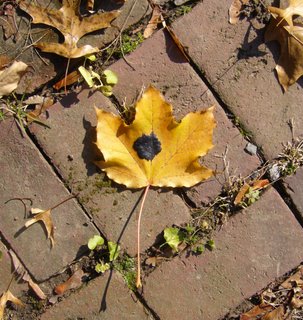The Black Spot
 Leaves are still falling in my neighborhood, and many of them look like this. Perhaps because at the moment I'm reading David Cordingly's Under the Black Flag, The Romance and the Reality of Life Among the Pirates, they remind me of Billy Bones's black spot in Treasure Island. Bones is so frightened when he receives it that he drops dead.
Leaves are still falling in my neighborhood, and many of them look like this. Perhaps because at the moment I'm reading David Cordingly's Under the Black Flag, The Romance and the Reality of Life Among the Pirates, they remind me of Billy Bones's black spot in Treasure Island. Bones is so frightened when he receives it that he drops dead.As a literary device, the black spot is brilliant. In reality, at least according to Cordingly, it didn't exist; Stevenson made it up. And Cordingly should know--he was Keeper of Pictures and Head of Exhibitions at the National Maritime Museum in Greenwich for a dozen years, and has authored other books on pirates and piracy, for which he's done extensive research.
The spots on maple leaves aren't really very scary, either. They're one of several different fungi in the genus Rhytisma, commonly called tar spot fungus. Tar spot can affect the leaves and also the keys of maple trees. Current research has shown that the tar spot fungus does not cause long term damage to the host. At worst, it can cause early leaf drop, and is a bit unsightly.
Because tar spot is a fungus, it spreads by spores. Thoroughly mulching or burning infected leaves is the way to prevent its spread, but this can be difficult, especially in a neighborhood like mine. In the suburbs, where I used to live, yard maintenance is a battle sport. Problems like tar spot are attacked mercilessly with the deadliest of weapons: pesticides, chainsaws, whatever. Downtowners don't have the equipment or the mindset to wage these campaigns. And yards are tiny--what's in my yard today may very well blow into yours tomorrow, so why bother?
Also, of course, as everybody knows, downtown is where the fringe people end up. Weirdos like me--writers, artists, hippies, homeless drunks. People who would look at tar spot fungus and think about Cordingly instead of Chemlawn.

